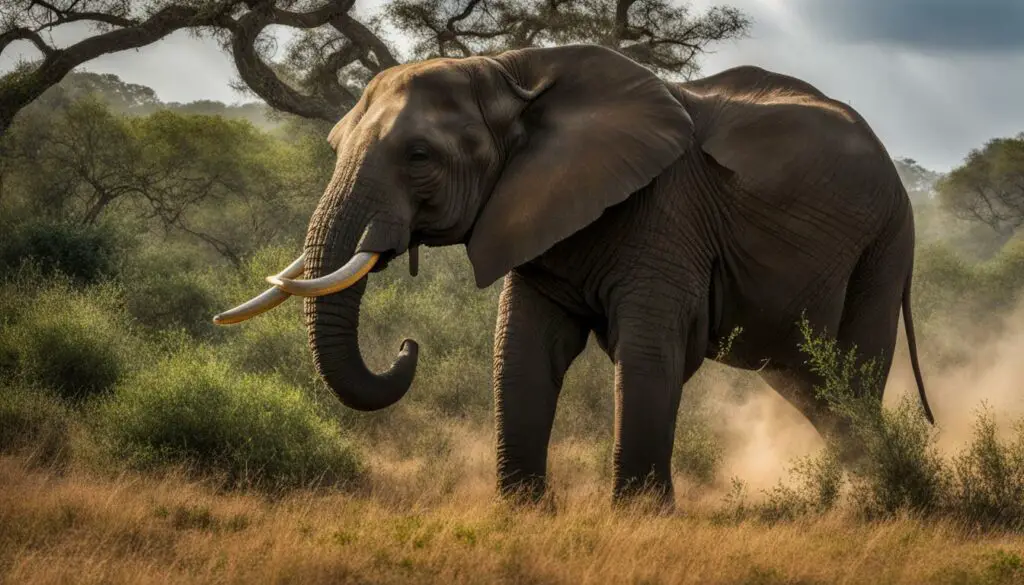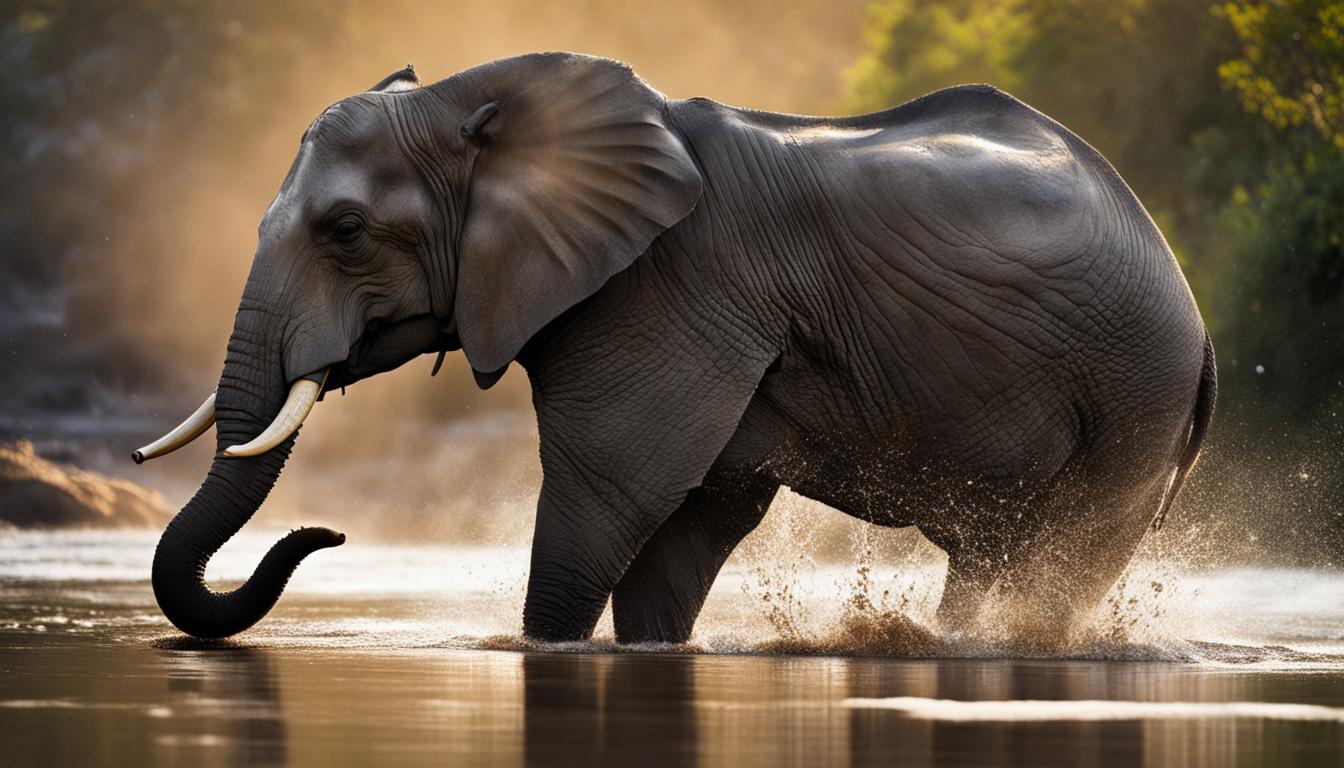Elephants have a versatile and powerful appendage called a trunk that serves various purposes. Their trunks are muscular, jointless structures capable of complex movements. Elephants use their trunks to drink, store and spray water, blow air to communicate, and grab food. Contrary to popular belief, the trunk does not act like a straw but rather functions as a storage unit. Elephants can also apply suction with their trunks to grab and lift objects, a behavior previously thought to be exclusive to fish. The trunk’s unique adaptations and functions make it an essential tool for elephants in their daily activities.
The Anatomy of an Elephant Trunk
An elephant’s trunk is an incredible organ that plays a vital role in their daily lives. It is made entirely of muscle and lacks joints or bones, allowing for remarkable flexibility and strength. Composed of thousands of muscles, the trunk is capable of complex and precise movements, enabling elephants to manipulate objects with ease.
The trunk’s structure includes two opposable “fingers” at the tip, which further enhance dexterity and control. Elephants can use their trunks to grab, lift, and carry objects of various sizes and weights. This adaptability is crucial for their survival and allows them to perform a wide range of tasks, such as gathering food, drinking water, and interacting with their environment.
The complexity of the elephant trunk lies in its intricate muscular system. Each movement of the trunk involves the coordinated effort of multiple muscles, working together to achieve the desired action. This sophisticated anatomy enables elephants to perform delicate tasks, such as picking up small items or even drawing water into their trunks to drink.
| Trunk Structure | Function |
|---|---|
| Muscular and jointless | Enables flexibility and strength in trunk movements |
| Opposable “fingers” at the tip | Enhances dexterity and precision in object manipulation |
| Complex muscular system | Coordinates movements for various tasks |
The intricate anatomy of the elephant trunk showcases the remarkable adaptability and functionality of this unique appendage. Its structure and muscular capabilities allow elephants to navigate their world with ease and perform essential activities for their survival.
Elephants’ Unique Sense of Smell
One of the most fascinating aspects of an elephant’s trunk is its remarkable sense of smell. With olfactory receptors more powerful than those of a bomb-sniffing dog, elephants can detect scents from miles away, using their trunks to investigate their surroundings. This keen sense of smell is crucial for various purposes, such as locating food, identifying potential threats, and communicating with other elephants.
The trunk acts as a highly effective sensory organ, providing elephants with the ability to navigate their environment with precision and gather information about their surroundings. This sensory capability is particularly important in their foraging behavior, allowing them to locate vegetation or potential water sources from long distances. Not only does their sense of smell help them survive in their natural habitats, but it also plays a vital role in their social interactions.
Elephants use their trunks to communicate with other members of their herd. They can pick up scent cues from urine, dung, or secretions of other elephants, which can convey information about an individual’s identity, reproductive state, and emotional state. By analyzing these olfactory signals, elephants can understand the presence and intentions of other elephants in their vicinity, aiding in the coordination of group movements and interactions.
The incredible sensory capabilities of the elephant trunk highlight its importance in the lives of elephants. It is not merely a tool for feeding or object manipulation, but also a sophisticated instrument that allows them to explore, communicate, and navigate their complex social and ecological environments.
The table below illustrates some fascinating facts about elephants’ sense of smell:
| Fact | Details |
|---|---|
| Powerful Olfactory Receptors | Elephants have olfactory receptors that are more powerful than those of a bomb-sniffing dog, enabling them to detect scents from miles away. |
| Locating Food | Their sense of smell helps them locate vegetation and potential water sources, allowing them to survive in their natural habitats. |
| Communication Tool | Elephants use their trunks to communicate with other elephants by picking up scent cues from urine, dung, and secretions, conveying important information about individuals’ identities, reproductive states, and emotions. |
| Navigational Aid | Their highly developed sense of smell enables them to navigate their environment with precision and gather information about their surroundings. |

The Power of Suction in Elephant Trunks
One of the most impressive abilities of elephant trunks is their power of suction. Elephants can use their trunks to drink water, suck up food, and manipulate objects with precision. A study conducted at Zoo Atlanta revealed that elephants can even pick up small food items, such as rutabaga cubes, from the ground using their suction capabilities.
The unique adaptations of the elephant trunk, including its large nostrils and specialized respiratory system, allow elephants to generate significant suction force. This suction is crucial for their feeding behaviors as it enables them to gather food from various sources. Additionally, elephants use suction to spray water onto their bodies for bathing and to cool down in hot climates.
Table:
| Elephant Trunk Suction | Feeding | Water Suction |
|---|---|---|
| Allows elephants to pick up small food items | Enables elephants to consume a diverse diet | Used for spraying water onto their bodies |
| Facilitates the intake of food from various sources | Aids in extracting nutrients from vegetation | Helps elephants cool down in hot climates |
| Provides precision in grasping and manipulating objects | Allows for efficient food consumption | Plays a role in maintaining their hygiene |
The power of suction in elephant trunks highlights the versatility and adaptability of this incredible appendage. From foraging for food to maintaining their hygiene, the trunk’s suction capabilities play a vital role in the daily activities of elephants, showcasing the remarkable functionality of this unique adaptation.
The Use of Trunks in Elephant Communication
Elephants have evolved the remarkable ability to use their trunks for communication purposes. Through their trunks, elephants can produce a wide range of vocalizations that serve as a means of long-distance communication among individuals. These vocalizations include loud bellows, trumpets, and low-frequency rumbles that can be heard for miles.
The elephant trunk serves as a powerful tool for producing these sounds. By blowing air through their trunks, elephants can modulate the pitch, volume, and duration of their vocalizations. This allows them to convey various messages to other elephants, including expressing their presence, emotions, and intentions.
“Elephant trunks function as natural amplifiers, allowing their vocalizations to travel long distances and communicate with other individuals in their social groups.”
In addition to vocalizations, elephants also use non-vocal sounds produced by their trunks to communicate. For example, they can create a variety of noises by slapping their trunks against the ground or water, which can serve as warning signals or territorial displays. This combination of vocal and non-vocal communication through their trunks forms an intricate system that is crucial for maintaining social cohesion within elephant herds.
Table: Examples of Elephant Trunk Vocalizations
| Vocalization Type | Description |
|---|---|
| Bellows | Loud, deep calls that can be heard over long distances, often used to announce presence or attract mates. |
| Trumpets | Short, high-pitched calls used for various purposes, including warning signals, expressing excitement, or calling for assistance. |
| Rumbles | Low-frequency, vibrating vocalizations that can convey different emotions and intentions, such as comfort, agitation, or submission. |
Overall, the use of their trunks in communication highlights the remarkable adaptability and complexity of elephants. By utilizing this versatile appendage, elephants can effectively convey information, establish social bonds, and navigate their complex social dynamics.
Trunk Size and Adaptations in Different Elephant Species
Elephants are known for their remarkable trunks, but did you know that the size and adaptations of these trunks can vary between different elephant species? Let’s take a closer look at the trunk size and characteristics of African and Asian elephants.
African Elephant Trunk: African elephants, the larger of the two species, typically have longer and heavier trunks compared to their Asian counterparts. The trunk of an African elephant can reach lengths of up to two meters and weigh around 140 kilograms. This larger trunk size is attributed to the African elephants’ need for greater strength and reach to access resources in their often more challenging habitats.
Asian Elephant Trunk: Asian elephants, on the other hand, have relatively smaller trunks compared to African elephants. The trunk of an Asian elephant typically measures around 1.5 meters in length and weighs approximately 100 kilograms. Despite their smaller size, Asian elephants have adapted their trunks to suit their specific needs, such as maneuvering through densely forested areas and foraging for a different range of food sources.
| Trunk Length (meters) | Trunk Weight (kilograms) | |
|---|---|---|
| African Elephant | Up to 2 | Around 140 |
| Asian Elephant | Approximately 1.5 | About 100 |
These size and adaptation differences in elephant trunks can be attributed to factors such as habitat, diet, and behavior. African elephants, with their larger trunks, rely heavily on them for various activities, including feeding, drinking, and communication. In contrast, Asian elephants have evolved trunks that are slightly shorter and lighter, allowing them to navigate more efficiently in their forested environments.
The variation in trunk size and adaptations among elephant species highlights their remarkable ability to adapt to different ecological niches. By studying these differences, researchers gain valuable insights into the behaviors and ecology of these magnificent creatures, aiding in their conservation and management.
Understanding the intricacies of trunk size and adaptations not only enhances our appreciation for the diversity within the elephant family but also provides valuable knowledge that may contribute to further advancements in robotics and conservation efforts. By drawing inspiration from the unique features of elephant trunks, scientists and engineers can develop innovative technologies, such as soft robotic manipulators, that have the potential to revolutionize various industries. Moreover, a deeper comprehension of elephant trunks can inform conservation strategies, helping to ensure the protection and preservation of these majestic animals for generations to come.
The Implications for Robotics and Conservation
The unique features and capabilities of elephant trunks have captivated the attention of scientists, engineers, and conservationists alike. The study of elephant trunk biomechanics and functionality has paved the way for advancements in robotics, particularly in the development of elephant trunk-inspired robots. These robots, equipped with soft robotic manipulators inspired by the remarkable capabilities of elephant trunks, have the potential to revolutionize various industries and tasks that require delicate and precise manipulation.
“The study of elephant trunk biomechanics has inspired the design of soft robotic manipulators, enabling robots to mimic the dexterity and strength of an elephant’s trunk.”
By studying the unique adaptations and functionalities of elephant trunks, researchers have gained insights that can be applied to the development of robot grippers with suction capabilities. Elephant trunks are known for their ability to apply suction and manipulate objects without causing damage. This impressive suction power has implications for industries such as manufacturing, healthcare, and even space exploration, where delicate handling of objects is crucial.
Furthermore, understanding the intricacies of elephant trunk functionality can also contribute to the conservation of these magnificent animals. Conservationists can use this knowledge to aid in the rehabilitation of injured elephants by developing prosthetic trunks or assistive devices that allow them to regain essential functionalities. Additionally, insights gained from studying elephant trunks can inform management practices and conservation strategies to ensure the long-term protection and well-being of wild elephant populations.
The Potential of Elephant Trunk Robotics
- Soft robotic manipulators inspired by the structure and functionality of elephant trunks have the potential to revolutionize industries such as manufacturing, healthcare, and space exploration.
- Robot grippers equipped with suction capabilities inspired by elephant trunks can handle delicate objects with precision, opening up new possibilities in various fields.
- Understanding elephant trunk biomechanics can aid in the development of assistive devices, such as prosthetic trunks, to assist injured elephants in regaining essential functionalities.
- Insights gained from studying elephant trunk functionality contribute to the conservation and management of wild elephant populations, ensuring their long-term protection.
With ongoing research and advancements in the field of robotics, as well as a deeper understanding of elephant trunk biomechanics, the potential applications and benefits of elephant trunk-inspired robotics continue to grow. By unlocking the secrets of this remarkable organ, we not only enhance our technological capabilities but also contribute to the preservation of these incredible animals and their natural habitats.
| Applications of Elephant Trunk-Inspired Robotics | Potential Benefits |
|---|---|
| Manufacturing | Improved manipulation of delicate objects, increased efficiency in assembly processes |
| Healthcare | Precise surgical procedures, enhanced prosthetics and assistive devices |
| Space Exploration | Delicate handling of objects in zero-gravity environments, improved exploration capabilities |
Conclusion
The elephant trunk is truly a marvel of nature, showcasing the incredible adaptability and functionality of these majestic creatures. Elephants utilize their trunks for a wide array of activities, including feeding, drinking, communication, and object manipulation. It is a multifunctional tool that plays a vital role in their daily lives.
The adaptations of the elephant trunk are nothing short of remarkable. With its muscular and jointless structure, the trunk exhibits impressive flexibility and strength. This unique appendage allows elephants to perform delicate tasks with precision, utilizing its two opposable “fingers” at the tip to grasp and manipulate objects.
Understanding the importance of elephant trunks extends beyond their incredible abilities. The study of elephant trunk biomechanics has the potential to inspire advancements in robotics, with applications ranging from soft robotic manipulators to improved gripper designs. Additionally, this knowledge contributes to conservation efforts, aiding in the recovery and management of injured elephants.
By recognizing the significance of elephant trunks and appreciating their adaptations, we can gain a deeper understanding of these magnificent animals and work towards their protection and preservation in the wild. The elephant trunk is truly a testament to the beauty and ingenuity of nature, and it continues to captivate our imagination and inspire scientific advancements.
Do Elephants Use Their Trunks During the Mating Process?
Elephants, known for their majestic trunks, employ these versatile appendages during the intricate process of elephants mating and reproduction cycle. These enormous creatures use their trunks for various purposes, including communication, gathering food, and even as an aid during mating rituals. The trunk plays a crucial role in signaling readiness and establishing physical contact between potential mates, making it an essential tool for elephants in their reproductive endeavors.
FAQ
How do elephants use their trunks for various activities?
Elephants use their trunks to drink, store and spray water, blow air for communication, and grab food.
What is the anatomy of an elephant trunk?
An elephant trunk is made entirely of muscle, lacks joints or bones, and has thousands of muscles and two opposable “fingers” at the tip.
What is unique about elephants’ sense of smell?
Elephants possess olfactory receptors more powerful than those of a bomb-sniffing dog, allowing them to detect scents from miles away using their trunks.
How do elephants use suction with their trunks?
Elephants can apply suction to drink water, suck up food, and manipulate objects, thanks to their unique trunk adaptations and specialized respiratory system.
How do elephants communicate using their trunks?
Elephants produce various sounds by blowing air through their trunks, including loud bellows for long-distance communication with other elephants.
How does trunk size differ between African and Asian elephants?
African elephants have longer and heavier trunks compared to their Asian counterparts, influenced by factors such as habitat, diet, and behavior.
What are the implications of elephant trunks for robotics and conservation?
The study of elephant trunk biomechanics can inspire advancements in soft robotic manipulators, while understanding trunk adaptations aids in conservation efforts.
What are the uses and importance of elephant trunks?
Elephant trunks are essential for feeding, drinking, communication, and object manipulation, playing a crucial role in the daily lives of elephants.










